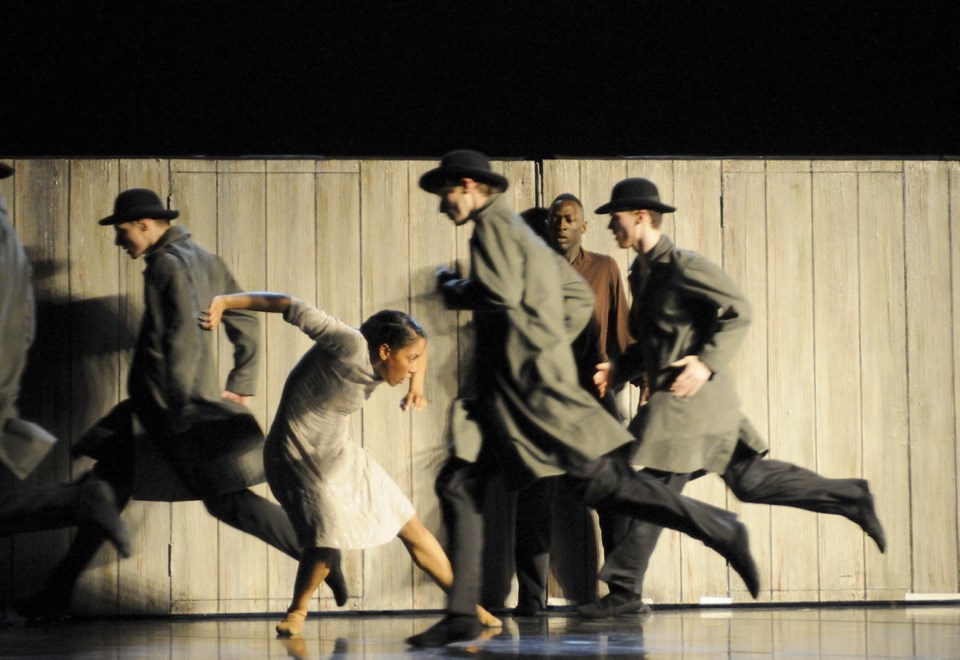What: Ballet B.C.
When: Thursday, Friday
Where: Royal Theatre
Rating: 4 stars (out of five)
Some doubted the ambitions of Emily Molnar when she took the helm of a struggling Ballet B.C., but the triple bill presented Thursday night embodied a vision worth getting behind.
The Vancouver-based company has reinvented itself under the former principal dancer, who was named artistic director in 2009 at a time when the company was on the verge of declaring bankruptcy.
Molnar has rebranded the troupe as contemporary, stripping it of excess fat in order to focus on exciting new works. And it’s working.
For a piece inspired by his aging parents, Jorma Elo’s I and I Am You is full of young energy. The Finnish-born choreographer watched his parents — one of whom is hard of hearing and the other visually impaired — guide one another in the world. There are hints of age in the piece, moments where you’re forced to slow down, where the dancers buckle for a moment into a hunch or wobble into balance, but in a moment they twitch back into fluid action. A pair could have danced this story in a very different way, but instead Elo employs 10 members of the troupe, who are urgent in their movement, spinning or leaping frantically. In pairs, they push one another to move or suddenly cause the other to pause.
The second piece was Molnar’s own 16 + a room. The title is appropriate in its simplicity — there’s a sense that the 16 dancers are exploring a space as they move around the stage. A dancer clad in a tank top and jeggings holds a sign: “This is a beginning.” A moment later, dancers in similar streetwear flood the stage then halt, looking like a Gap ad. They alternate between moving as individuals and as one, leaning all together toward one corner before stampeding toward it and grinding to another halt — a study in momentum, like water splashing against the side of a glass.
Molnar says she wrote the piece as she reached 40, feeling a kind of sadness in her body. But it’s not a sad piece — when the sign-holder returns, we’re reminded that there are multiple beginnings, before another scene takes shape.
Dirk Haubrich’s electronic score pulses and clanks, as well as hums as though frozen and buzzes with electricity like insects beating their wings. Molnar has the privilege of knowing her dancers and their individuality shows through in this one.
Both Elo and Molnar’s works fit with her vision of staging new works — both were created for the company and premièred in Vancouver this fall.
But the night’s standout was Johan Inger’s award-winning Walking Mad, which premièred in the Netherlands in 2001 (Ballet B.C. is the first to perform it in Canada.)
“Our greatest blessings come to us by way of madness,” the Swedish choreographer quoted Aristotle in a program note, and it could equally be applied to his own creation. On it’s own, it’s a five-star performance.
The piece is gloriously silly from the beginning. A man wanders across the stage before the curtain has even risen. Curiosity gets the better of him and he lifts the bottom, prompting it to rise and reveal a scene backed by the piece’s real star: A wall.
The wall is a party. The wall is a prison. It’s a hiding place, a portal and a maker of magic — a person need only dip her hand behind one side to grab an unsuspecting stranger’s hat metres away. Its trap doors, fold-down sections and movable halves act as dance partners to the troupe.
You can be pinned to it, you can leap to its crest, or you can collapse against it. There’s a Broadway-like energy about it all. But while there’s a lot of clowning, it’s at no expense to the dance, which keeps pace with Ravel’s Bolero.
The pure joy of the first act of Walking Mad is what makes the second short act, danced to the spare piano in Für Alina by Arvo Pärt, so heartbreaking. The pas de deux shows the other side of madness — the feeling of losing oneself or a loved one — and was danced tenderly Thursday night.
